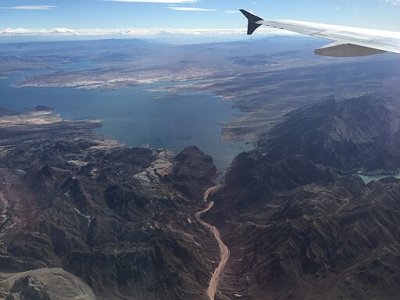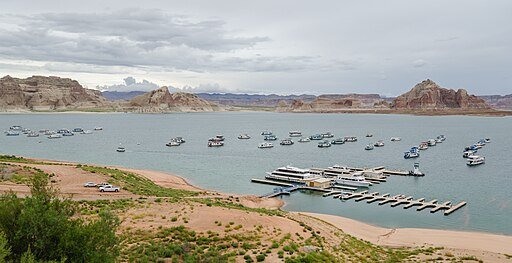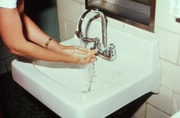Troubling signs out West—Could your water supply be at risk? Two lakes remain dangerously low at just 35% full.
- Replies 0
As the golden sunsets cast long shadows over the Western United States, a less picturesque scenario unfolds beneath the surface.
The region's lifeblood, its water supply, is in jeopardy. The iconic Lakes Mead and Powell, vast reservoirs on the Colorado River, are alarmingly low at just 35% full.
This stark reality poses a question that resonates through every household: Is your water at risk?
Recent rains and floods in California offered a momentary sigh of relief, but as spring heralds the onset of the West's dry season, the specter of drought looms large once again.
While the storms have somewhat eased the state's drought conditions, they are but a drop in the bucket when it comes to replenishing the thirsty Colorado River basin.
The Colorado River, a lifeline for seven states and Mexico, is facing a crisis decades in the making. Colorado State climatologist Russ Schumacher paints a grim picture, "because of the warm, dry conditions over the last couple of decades, which have been made worse by a warming climate, and also because of high demand for water in the region, the two big reservoirs on the Colorado River (Lakes Mead and Powell) are still very low compared to their historical levels."

Despite being slightly better off than the record lows of a few years ago, Lakes Mead and Powell are still holding only about half the water they averaged over the last 40 years.
Brian Fuchs of the National Drought Mitigation Center confirmed that while "Powell and Mead are in slightly better shape than a few years ago when they were at record lows and it really was a crisis situation, they are still only holding about half of the water compared to the average over the last 40 years."
The reservoirs' vast storage capacity remains underutilized, waiting for nature to take its course and deliver much-needed precipitation.
The mountain snowpack in the Upper Colorado River basin, which feeds into Lake Powell, recently received a boost from the storms, climbing from 82% to 94% of its average. This snowpack is a critical source of water for the West, but its benefits are not evenly distributed.
In contrast, the Lower Colorado River basin is experiencing a severe “snow drought,” with snowpack levels reaching only 35% of average even after the recent storms.
"Exceptional snow drought persists in the Southwest (Arizona, Colorado, Nevada, New Mexico, Utah) as a result of record dry conditions," according to Drought.gov.
The US Drought Monitor continues to report moderate to extreme drought conditions throughout much of the Colorado River basin, with the situation worsening as one travels southwest.

The Colorado River Basin Forecast Center predicts only 70% of the average flow into Lake Powell this spring and summer. The medium-range forecast doesn't offer much hope, with warm and dry conditions expected to persist into early March.
Schumacher also said that the precipitation for this water year (starting from October 1) is well below average over the Southwest. Several locations in the region have also been extremely dry since October.
Without a significant change in weather patterns, he lamented that "...unless the pattern changes to bring some huge snowstorms in the spring, it’s likely to be another year with very low flows on the Colorado River."
The implications of this water crisis are far-reaching. Municipal water supplies, agricultural irrigation, and the natural environment all hinge on the health of the Colorado River.
Recommended for you: Dangerous freeze alert! Protect yourself from the deadly cold wave sweeping the US
As reservoir levels drop, water restrictions become a real possibility, and the cost of water can rise, affecting everything from your utility bill to the price of produce at the grocery store.
In the face of this challenge, conservation becomes more than a choice—it's a necessity. Simple actions like fixing leaks, reducing outdoor watering, and choosing drought-resistant plants for landscaping can make a difference.
Also read: Brewing trouble: Is a global coffee price surge coming for your cup?

Have you noticed changes in your local water supply or restrictions in your area? Are you taking steps to conserve water in your daily life? Share your experiences and tips with the GrayVine community in the comments below!
The region's lifeblood, its water supply, is in jeopardy. The iconic Lakes Mead and Powell, vast reservoirs on the Colorado River, are alarmingly low at just 35% full.
This stark reality poses a question that resonates through every household: Is your water at risk?
Recent rains and floods in California offered a momentary sigh of relief, but as spring heralds the onset of the West's dry season, the specter of drought looms large once again.
While the storms have somewhat eased the state's drought conditions, they are but a drop in the bucket when it comes to replenishing the thirsty Colorado River basin.
The Colorado River, a lifeline for seven states and Mexico, is facing a crisis decades in the making. Colorado State climatologist Russ Schumacher paints a grim picture, "because of the warm, dry conditions over the last couple of decades, which have been made worse by a warming climate, and also because of high demand for water in the region, the two big reservoirs on the Colorado River (Lakes Mead and Powell) are still very low compared to their historical levels."

Lakes Mead and Powell, key reservoirs on the Colorado River, are currently only at about 35% of their full capacity despite recent rains. Image source: Famartin / Wikimedia Commons.
Despite being slightly better off than the record lows of a few years ago, Lakes Mead and Powell are still holding only about half the water they averaged over the last 40 years.
Brian Fuchs of the National Drought Mitigation Center confirmed that while "Powell and Mead are in slightly better shape than a few years ago when they were at record lows and it really was a crisis situation, they are still only holding about half of the water compared to the average over the last 40 years."
The reservoirs' vast storage capacity remains underutilized, waiting for nature to take its course and deliver much-needed precipitation.
The mountain snowpack in the Upper Colorado River basin, which feeds into Lake Powell, recently received a boost from the storms, climbing from 82% to 94% of its average. This snowpack is a critical source of water for the West, but its benefits are not evenly distributed.
In contrast, the Lower Colorado River basin is experiencing a severe “snow drought,” with snowpack levels reaching only 35% of average even after the recent storms.
"Exceptional snow drought persists in the Southwest (Arizona, Colorado, Nevada, New Mexico, Utah) as a result of record dry conditions," according to Drought.gov.
The US Drought Monitor continues to report moderate to extreme drought conditions throughout much of the Colorado River basin, with the situation worsening as one travels southwest.

Experts are concerned that the recent storms will not alleviate the long-term drought conditions in the southwestern United States as the region enters its dry season. Image source: Tuxyso / Wikimedia Commons.
The Colorado River Basin Forecast Center predicts only 70% of the average flow into Lake Powell this spring and summer. The medium-range forecast doesn't offer much hope, with warm and dry conditions expected to persist into early March.
Schumacher also said that the precipitation for this water year (starting from October 1) is well below average over the Southwest. Several locations in the region have also been extremely dry since October.
Without a significant change in weather patterns, he lamented that "...unless the pattern changes to bring some huge snowstorms in the spring, it’s likely to be another year with very low flows on the Colorado River."
The implications of this water crisis are far-reaching. Municipal water supplies, agricultural irrigation, and the natural environment all hinge on the health of the Colorado River.
Recommended for you: Dangerous freeze alert! Protect yourself from the deadly cold wave sweeping the US
As reservoir levels drop, water restrictions become a real possibility, and the cost of water can rise, affecting everything from your utility bill to the price of produce at the grocery store.
In the face of this challenge, conservation becomes more than a choice—it's a necessity. Simple actions like fixing leaks, reducing outdoor watering, and choosing drought-resistant plants for landscaping can make a difference.
Also read: Brewing trouble: Is a global coffee price surge coming for your cup?
Key Takeaways
- Lakes Mead and Powell, key reservoirs on the Colorado River, are currently only at about 35% of their full capacity despite recent rains.
- Experts are concerned that the recent storms will not alleviate the long-term drought conditions in the southwestern United States as the region enters its dry season.
- The mountain snowpack, crucial for water supplies in the West, has improved but remains below average levels, exacerbating concerns about water availability.
- Forecasters predict only 70% of the average flow into Lake Powell this spring and summer, and the medium-range forecast suggests warm and dry conditions will persist, potentially leading to very low flows on the Colorado River.
Have you noticed changes in your local water supply or restrictions in your area? Are you taking steps to conserve water in your daily life? Share your experiences and tips with the GrayVine community in the comments below!






